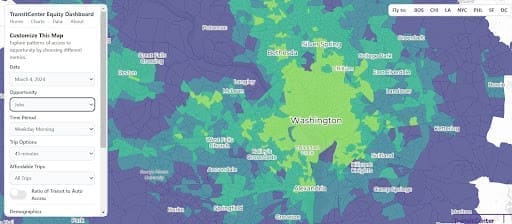One of the biggest generators of the humble bus’s impressive ridership recovery has been improved off-peak service, enabling regional residents to get where they need to go late night, mid-day, and weekends — the latter accounting for 25% of total bus ridership.
Although Metrorail ridership still lags behind its pre-pandemic performance, the Washington region’s steadily increasing access to jobs and opportunities via transit over the last two years has largely gone undocumented. Some of the most significant boosts in transit access have happened in corners of the region that have needed it the most for decades, including Northern Virginia, Montgomery County, and Southeast DC. TransitCenter’s newly updated Transit Equity Dashboard makes it easy to explore the data behind the region’s ridership recovery, whether you are a policymaking professional, enthused advocate, or a data dilettante. [Disclosure: TransitCenter provides grant support for GGWash’s transportation equity work. GGWash maintains independence over its editorial content.]
As DMVMoves, an initiative organized by the Metropolitan Washington Council of Governments (COG) and the Washington Metropolitan Area Transit Authority (WMATA), has leaders deliberating over a regional vision and funding model for transit, the dashboard can be a tool for understanding the wider issues behind mobility in the region.
Measuring mobility
TransitCenter first released its dashboard examining the ridership of America’s seven largest transit systems in 2020, but given how much has changed in the four years since an update to answer the question of how well public transportation is serving riders across race, income, genders, and abilities was long overdue, especially given the serious fiscal crises facing many systems.
“You can’t manage what you can’t measure,” said Hayley Richardson, communications director at TransitCenter. “Access to opportunity is the thing we should be measuring in transit now, so agencies and advocates need to understand where the racial access gaps are to help inform investments and know where agencies should put additional resources.”
Researchers Mary Buchanan and Willem Klumpenhouwer found that only three of the top seven agencies nationwide are running more service today than they were pre-pandemic. That means that residents of DC, New York City, and Los Angeles are enjoying better transit access than they did five years ago while riders in Chicago, Philadelphia, Boston, and San Francisco are worse off than in 2019.
“DC is a great example of what can happen when agencies use their resources smartly to invest in off-peak service,” Richardson said. “DC’s growth in access to opportunity via transit surpasses all other cities we looked at. Ridership on WMATA is bounding back faster than at other agencies which is a testament to the fact that when you put out good service, riders will come.”

The Transit Equity Dashboard also showed big gains in access to opportunity for Alexandria residents, highlighting DASH’s record bus ridership in 2023 thanks to its route redesign and permanent elimination of fares. The new Potomac Yard station in Alexandria and the second phase of the Silver Line both boosted Northern Virginia’s score over 2020.
“This dashboard shows the value of frequent all-day service now as people’s schedules have shifted,” said Bill Pugh, senior policy fellow at the Coalition for Smarter Growth. “This should be a sign of the importance of long-term dedicated funding for Metro. Other transit agencies can make multi-year decisions about service levels, but it’s more difficult for WMATA without dedicated funding.”
Persistent problems
Despite the region’s overall increase in transit access, deep disparities remain between the District’s Black and white populations. Nowhere is that inequity more apparent than in access to healthcare via transit. The average white resident of the region lives 20 minutes away from the nearest hospital via transit, while the average Black resident needs an additional five minutes to access a hospital. Much of the disparity is due to the lack of any hospitals in DC’s Ward 7 or in Prince George’s County, but good public transit can be part of the solution.
“White residents overall have better access to jobs and healthcare via transit, but Black residents ride transit more,” Richardson said. “Redesigning WMATA’s bus service would help, but the agency can’t close regional access gaps without more funding.”
Besides a few pockets, nowhere in the region is public transportation truly competitive with cars. Even in much of the District itself, it takes residents three to five times longer to get their groceries via transit than it would take them by car. “That all relates back to what elected officials are spending public money on, i.e. car infrastructure instead of transit funding,” said Richardson.
Kai Hall, Policy Officer at Greater Greater Washington who manages the DC Transportation Equity Network (DC TEN), wants to bring more light and empathy to that issue by encouraging DC leaders and residents to participate in an upcoming challenge to drive less over one week in October. “That’s one of the reasons why the TEN is organizing the Week Without Driving in DC, to highlight the challenges that people who don’t drive face in a system that prioritizes cars over other forms of transportation.”
With tools like the updated Transit Equity Dashboard, that is something advocates like Pugh hope to change. The improvements to reliability, customer service, and frequency made under general manager Randy Clarke have led to the highest levels of rider satisfaction seen in a long time. To Pugh, such progress has shown that further improvements are not a pipe dream but rather a simple question of consistent funding.
“Hopefully, this will generate more conversation and reinforce the need for the service expansion proposals that Metro and other operators and local jurisdictions have proposed, including more frequent all-day service, new bus rapid transit lines, and other improvements to speed up bus service,” he said.




